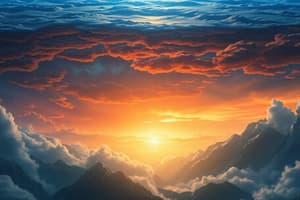Podcast
Questions and Answers
What is the sky composed of?
What is the sky composed of?
Nitrogen (78%), Oxygen (21%), Argon (1%), and Carbon dioxide and other gases (trace amounts)
What is the lowest layer of the atmosphere called?
What is the lowest layer of the atmosphere called?
Troposphere
What causes the blue color of the daytime sky?
What causes the blue color of the daytime sky?
Scattering of sunlight by atmospheric gases
What are clouds formed from?
What are clouds formed from?
What causes the spectacular displays of colored light in polar regions?
What causes the spectacular displays of colored light in polar regions?
What causes the streaks of light during meteor showers?
What causes the streaks of light during meteor showers?
Flashcards are hidden until you start studying
Study Notes
Definition and Composition
- The sky is the atmosphere seen from the Earth's surface, appearing as a dome above the horizon
- Composed of:
- Nitrogen (78%)
- Oxygen (21%)
- Argon (1%)
- Carbon dioxide and other gases (trace amounts)
Layers of the Atmosphere
- Troposphere: lowest layer, extends up to 12 km (7.5 miles) above Earth's surface
- Stratosphere: 12-50 km (7.5-31 miles) above Earth's surface, contains ozone layer
- Mesosphere: 50-85 km (31-53 miles) above Earth's surface, meteors burn up here
- Thermosphere: 85-600 km (53-373 miles) above Earth's surface, aurorae occur here
- Exosphere: outermost layer, extends from 500-10,000 km (310-6,214 miles) above Earth's surface
Phenomena and Features
- Daytime sky: blue color due to scattering of sunlight by atmospheric gases
- Sunrise and sunset: colors due to scattering of shorter wavelengths (blue, violet) and longer wavelengths (red, orange)
- Clouds: formed from water vapor and condensation nuclei
- Aurorae: spectacular displays of colored light in polar regions, caused by solar wind interacting with magnetic fields
- Meteor showers: streaks of light from small meteoroids entering Earth's atmosphere
Sky and Atmosphere
- The sky is the atmosphere seen from the Earth's surface, appearing as a dome above the horizon.
- The atmosphere is composed of 78% nitrogen, 21% oxygen, 1% argon, and trace amounts of carbon dioxide and other gases.
Layers of the Atmosphere
- The troposphere is the lowest layer, extending up to 12 km (7.5 miles) above the Earth's surface.
- The stratosphere is the next layer, spanning 12-50 km (7.5-31 miles) above the Earth's surface, and contains the ozone layer.
- The mesosphere is the layer where meteors burn up, extending from 50-85 km (31-53 miles) above the Earth's surface.
- The thermosphere is the layer where aurorae occur, spanning 85-600 km (53-373 miles) above the Earth's surface.
- The exosphere is the outermost layer, extending from 500-10,000 km (310-6,214 miles) above the Earth's surface.
Atmospheric Phenomena
- The daytime sky appears blue due to the scattering of sunlight by atmospheric gases.
- The colors of sunrise and sunset are caused by the scattering of shorter wavelengths (blue, violet) and longer wavelengths (red, orange).
- Clouds are formed from water vapor and condensation nuclei.
- Aurorae are spectacular displays of colored light in polar regions, caused by solar wind interacting with magnetic fields.
- Meteor showers are streaks of light from small meteoroids entering the Earth's atmosphere.
Studying That Suits You
Use AI to generate personalized quizzes and flashcards to suit your learning preferences.




